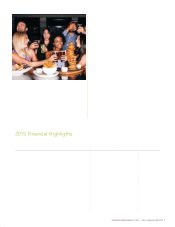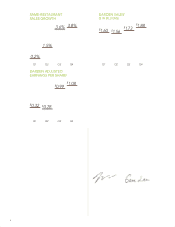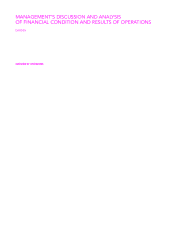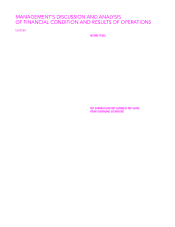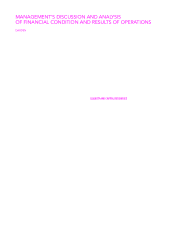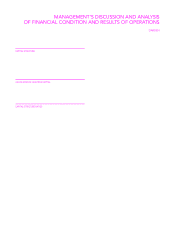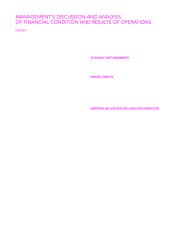Red Lobster 2015 Annual Report Download - page 19
Download and view the complete annual report
Please find page 19 of the 2015 Red Lobster annual report below. You can navigate through the pages in the report by either clicking on the pages listed below, or by using the keyword search tool below to find specific information within the annual report.
DARDEN RESTAURANTS, INC. | 2015 ANNUAL REPORT 15
MANAGEMENT’S DISCUSSION AND ANALYSIS
OF FINANCIAL CONDITION AND RESULTS OF OPERATIONS
DARDEN
Net earnings from continuing operations for fiscal 2014 decreased
22.8 percent and diluted net earnings per share from continuing operations
decreased 23.3 percent compared with fiscal 2013 primarily due to higher food
and beverage costs and restaurant expenses as a percent of sales, partially
offset by increased sales and a lower effective income tax rate. Our diluted net
earnings per share from continuing operations for fiscal 2014 were adversely
impacted by approximately $0.23, comprised of:
• Approximately $0.10 due to legal, financial advisory and other costs
related to implementation of the strategic action plan announced in
December 2013;
• Approximately $0.08 due to asset impairment charges; and
• Approximately $0.05 due to costs associated with our September
2013 workforce reduction.
EARNINGS FROM DISCONTINUED OPERATIONS
On an after-tax basis, earnings from discontinued operations for fiscal 2015
were $513.1 million ($3.96 per diluted share) compared with earnings from
discontinued operations for fiscal 2014 of $103.0 million ($0.77 per diluted
share) and fiscal 2013 of $174.6 million ($1.33 per diluted share). In fiscal
2015, we recorded a pre-tax gain of $837.0 million on the sale of Red
Lobster as described above. The decrease in earnings from discontinued
operations in fiscal 2014 was primarily driven by a decrease in sales and
overall performance at Red Lobster in addition to separation-related costs
(approximately $0.10 per diluted share) and impairments recorded for the
two closed company-owned synergy locations (approximately $0.04 per
diluted share).
SEASONALITY
Our sales volumes fluctuate seasonally. Typically, our average sales per
restaurant are highest in the spring and winter, followed by the summer, and
lowest in the fall. Holidays, changes in the economy, severe weather and
similar conditions may impact sales volumes seasonally in some operating
regions. Because of the seasonality of our business, results for any quarter
are not necessarily indicative of the results that may be achieved for the full
fiscal year.
IMPACT OF INFLATION
We attempt to minimize the annual effects of inflation through appropriate
planning, operating practices and menu price increases. We experienced
higher than normal inflationary costs during fiscal 2015 and fiscal 2014 and
were able to partially reduce the annual impact utilizing these strategies. We
do not believe inflation had a significant overall effect on our annual results
of operations during fiscal 2013.
CRITICAL ACCOUNTING POLICIES
We prepare our consolidated financial statements in conformity with U.S.
generally accepted accounting principles. The preparation of these financial
statements requires us to make estimates and assumptions that affect the
reported amounts of assets and liabilities and disclosure of contingent assets
and liabilities at the date of the financial statements and the reported amounts
of sales and expenses during the reporting period. Actual results could differ
from those estimates.
Our significant accounting policies are more fully described in Note 1 to
the consolidated financial statements. However, certain of our accounting
policies that are considered critical are those we believe are both most
important to the portrayal of our financial condition and operating results and
require our most difficult, subjective or complex judgments, often as a result
of the need to make estimates about the effect of matters that are inherently
uncertain. Judgments and uncertainties affecting the application of those
policies may result in materially different amounts being reported under different
conditions or using different assumptions. We consider the following policies to
be most critical in understanding the judgments that are involved in preparing
our consolidated financial statements.
Land, Buildings and Equipment, Net
Land, buildings and equipment are recorded at cost less accumulated
depreciation. Building components are depreciated over estimated useful
lives ranging from 7 to 40 years using the straight-line method. Leasehold
improvements, which are reflected on our consolidated balance sheets as a
component of buildings in land, buildings and equipment, net, are amortized
over the lesser of the expected lease term, including cancelable option periods,
or the estimated useful lives of the related assets using the straight-line
method. Equipment is depreciated over estimated useful lives ranging from
2 to 15 years, also using the straight-line method.
Our accounting policies regarding land, buildings and equipment, including
leasehold improvements, include our judgments regarding the estimated useful
lives of these assets, the residual values to which the assets are depreciated
or amortized, the determination of what constitutes expected lease term and
the determination as to what constitutes enhancing the value of or increasing
the life of existing assets. These judgments and estimates may produce
materially different amounts of reported depreciation and amortization expense
if different assumptions were used. As discussed further below, these
judgments may also impact our need to recognize an impairment charge
on the carrying amount of these assets as the cash flows associated with
the assets are realized, or as our expectations of estimated future cash
flows change.
Leases
We are obligated under various lease agreements for certain restaurants. For
operating leases, we recognize rent expense on a straight-line basis over the
expected lease term, including option periods as described below. Capital
leases are recorded as an asset and an obligation at an amount equal to the
present value of the minimum lease payments during the lease term. Sale
leasebacks are transactions through which we sell assets (such as restaurant
properties) at fair value and subsequently lease them back. The resulting
leases generally qualify and are accounted for as operating leases. Financing
leases are generally the product of a failed sale-leaseback transaction and
result in retention of the “sold” assets within land, building and equipment
with a financing lease obligation equal to the amount of proceeds received
recorded as a component of other liabilities on our consolidated balance sheets.
Within the provisions of certain of our leases, there are rent holidays and
escalations in payments over the base lease term, as well as renewal periods.
The effects of the holidays and escalations have been reflected in rent expense
on a straight-line basis over the expected lease term, which includes cancel-
able option periods we are reasonably assured to exercise because failure to
exercise such options would result in an economic penalty to the Company.
The lease term commences on the date when we have the right to control
the use of the leased property, which is typically before rent payments are
due under the terms of the lease. The leasehold improvements and property
held under capital leases for each restaurant facility are amortized on the
straight-line method over the shorter of the estimated life of the asset or the
same expected lease term used for lease accounting purposes. Many of our
leases have renewal periods totaling 5 to 20 years, exercisable at our option,


